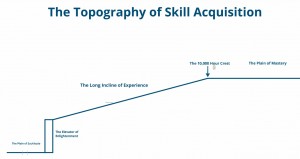 In Part 1 of this series, I wrote about what I think makes someone “different”, in relation to the ALIA Information Online Conference’s theme “be different. do different.” I asserted that it was acquiring skills that you are not supposed to have that sets you apart. If you go along with that, at least for the sake of argument, then it seems clear that skill acquisition is the key. And if it is, then we should all know how to do it well.
In Part 1 of this series, I wrote about what I think makes someone “different”, in relation to the ALIA Information Online Conference’s theme “be different. do different.” I asserted that it was acquiring skills that you are not supposed to have that sets you apart. If you go along with that, at least for the sake of argument, then it seems clear that skill acquisition is the key. And if it is, then we should all know how to do it well.
The first thing you should know is that skill acquisition has a topography. I think you probably knew that it wasn’t simply a flat plain that you could easily traverse from novice to expert, but it is more complicated than you might imagine at first. Allow me to elucidate.
The topography of skill acquisition has several distinct parts that I will discuss in more depth in future posts. For now, I’ll briefly introduce each:
- The Plain of Suckitude — Where we all begin, and where some of us die.
- The Elevator of Enlightenment — The “aha” moment when muscle memory and/or our thought patterns kick in.
- The Long Incline of Experience — Using the skill over time. Many of us camp here.
- The 10,000 Hour Crest — The spot that only some reach, popularized by Malcolm Gladwell in the book Outliers: The Story of Success.
- The Plain of Mastery — For those who have achieved the 10,000 hours of experience, the long comfortable glide that only true mastery of a skill brings.
As I mentioned, in subsequent posts I’ll address each of these stages in turn, leading up to the denouement, “How Not to Die on the Plain of Suckitude” — which is, after all, what we want.
Next Up: The Plain of Suckitude

